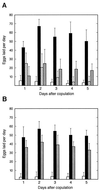Drosophila female sexual behavior induced by sterile males showing copulation complementation
- PMID: 10725377
- PMCID: PMC16228
- DOI: 10.1073/pnas.97.7.3272
Drosophila female sexual behavior induced by sterile males showing copulation complementation
Abstract
Females of most animal species are usually inseminated by more than one male, which allows sperm from different males to compete for fertilization. To prevent invasion of sperm from other males, Drosophila males elicit a rejection behavior in their mates after copulation. Using paired mutant males that, for the lack of accessory glands, are sterile, we show that this rejection behavior is induced exclusively by the secreted accessory gland products transferred to the female during copulation. Moreover, the activities of sperm and accessory gland products are complementary and interdependent: both sperm fertility and rejection behavior depend on accessory gland products whose prolonged activities, in turn, require the presence of sperm. Fertility of sperm from paired males can be restored by accessory gland products of spermless males in "copulation complementation" experiments. Our observations may have important implications for the role of sexual behavior in evolution and for the treatment of male sexual dysfunction in humans.
Figures



Similar articles
-
Relationship between male age, accessory gland, sperm transferred, and fitness traits in Drosophila bipectinata.J Insect Sci. 2013;13:159. doi: 10.1673/031.013.15901. J Insect Sci. 2013. PMID: 24785586 Free PMC article.
-
Hybrid male sterility between Drosophila willistoni species is caused by male failure to transfer sperm during copulation.BMC Evol Biol. 2015 May 1;15:75. doi: 10.1186/s12862-015-0355-8. BMC Evol Biol. 2015. PMID: 25925738 Free PMC article.
-
Postcopulatory Behavior of Tephritid Flies.Annu Rev Entomol. 2023 Jan 23;68:89-108. doi: 10.1146/annurev-ento-120220-113618. Epub 2022 Oct 5. Annu Rev Entomol. 2023. PMID: 36198400 Review.
-
Why it is difficult to model sperm displacement in Drosophila melanogaster: the relation between sperm transfer and copulation duration.Evolution. 2000 Apr;54(2):534-42. doi: 10.1111/j.0014-3820.2000.tb00056.x. Evolution. 2000. PMID: 10937230
-
An integrative view of sexual selection in Tribolium flour beetles.Biol Rev Camb Philos Soc. 2008 May;83(2):151-71. doi: 10.1111/j.1469-185X.2008.00037.x. Biol Rev Camb Philos Soc. 2008. PMID: 18429767 Review.
Cited by
-
True polyandry and pseudopolyandry: why does a monandrous fly remate?BMC Evol Biol. 2013 Jul 25;13:157. doi: 10.1186/1471-2148-13-157. BMC Evol Biol. 2013. PMID: 23885723 Free PMC article.
-
Mating affects reproductive investment into eggs, but not the timing of oogenesis in the flesh fly Sarcophaga crassipalpis.J Comp Physiol B. 2008 Feb;178(2):225-33. doi: 10.1007/s00360-007-0216-x. Epub 2007 Oct 24. J Comp Physiol B. 2008. PMID: 17957374
-
Loss of circadian clock function decreases reproductive fitness in males of Drosophila melanogaster.Proc Natl Acad Sci U S A. 2002 Feb 19;99(4):2134-9. doi: 10.1073/pnas.032426699. Proc Natl Acad Sci U S A. 2002. PMID: 11854509 Free PMC article.
-
Pelle Modulates dFoxO-Mediated Cell Death in Drosophila.PLoS Genet. 2015 Oct 16;11(10):e1005589. doi: 10.1371/journal.pgen.1005589. eCollection 2015 Oct. PLoS Genet. 2015. PMID: 26474173 Free PMC article.
-
Sexual conflict and seminal fluid proteins: a dynamic landscape of sexual interactions.Cold Spring Harb Perspect Biol. 2014 Dec 11;7(2):a017533. doi: 10.1101/cshperspect.a017533. Cold Spring Harb Perspect Biol. 2014. PMID: 25502515 Free PMC article. Review.
References
-
- Parker G A. Biol Rev. 1970;45:525–567.
-
- Birkhead T R, Møller A P. Sperm Competition and Sexual Selection. London: Academic; 1998.
-
- Smith R L. Sperm Competition and the Evolution of Animal Mating Systems. New York: Academic; 1984. - PubMed
-
- Birkhead T R, Møller A P. Sperm Competition in Birds: Evolutionary Causes and Consequences. London: Academic; 1992.
-
- Simmons L W, Siva-Jothy M T. In: Sperm Competition and Sexual Selection. Birkhead T R, Møller A P, editors. London: Academic; 1998. pp. 341–434.
Publication types
MeSH terms
LinkOut - more resources
Full Text Sources
Molecular Biology Databases

